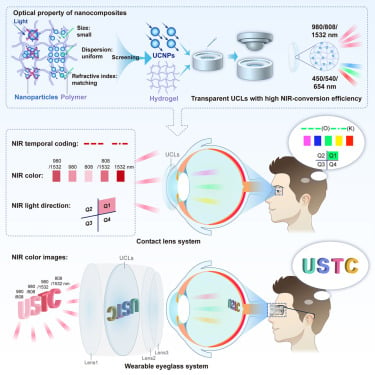Scientists have developed contact lenses that grant humans the ability to see infrared light, opening up a previously invisible world of thermal signatures and wavelengths beyond normal human perception.
The breakthrough transparent lenses use upconversion nanoparticles to transform near-infrared radiation into visible light, allowing wearers to detect information that would normally require bulky night vision equipment. Researchers successfully tested the lenses on both mice and human volunteers, demonstrating the ability to perceive infrared patterns, distinguish temporal codes like Morse signals, and even see in full color across multiple infrared wavelengths—all while maintaining normal vision.
The Science Behind Superhuman Sight

The technology builds on a fundamental limitation of mammalian vision: humans can only perceive a narrow slice of the electromagnetic spectrum between 400-700 nanometers. This leaves over half of solar energy—existing as infrared light above 700 nanometers—completely invisible to our eyes.
The research team, led by scientists at the University of Science and Technology of China, embedded specially designed upconversion nanoparticles into soft contact lens materials. These nanoparticles convert near-infrared light into visible wavelengths that human photoreceptors can detect.
What makes this approach particularly elegant is its non-invasive nature. Previous attempts to grant infrared vision required surgical injection of nanoparticles directly into the eye—a procedure most humans would understandably resist.
Testing the Infrared Vision
The researchers first validated their approach using mice, which wore the contact lenses during various behavioral tests. The results were striking: mice with the lenses could distinguish infrared patterns, respond to infrared temporal codes, and even exhibited enhanced infrared sensitivity when their eyes were closed, thanks to infrared light’s superior ability to penetrate tissue.
Human testing proved equally successful. Volunteers wearing the lenses could accurately identify infrared light patterns and distinguish flickering signals that could encode information like Morse code. Even more remarkably, participants maintained full infrared sensitivity in normal daylight conditions, demonstrating that the technology works alongside natural vision rather than replacing it.
Key Performance Metrics:
- Contact lenses maintained over 90% transparency across visible wavelengths
- Nanoparticle concentration reached 7% by mass while preserving optical clarity
- Infrared penetration through eyelids was 60 times greater than visible light
- Spatial resolution achieved ~65 cycles per degree, comparable to normal human vision
- Color vision enabled across three distinct infrared wavelength bands
Full-Color Infrared Vision
Perhaps most impressively, the team developed trichromatic contact lenses that grant full-color infrared vision. By incorporating three different types of upconversion nanoparticles, each tuned to different infrared wavelengths, the lenses can convert infrared radiation into red, green, and blue visible light.
This creates an entirely new dimension of visual information. Objects that appear identical in visible light may show dramatically different colors in the infrared spectrum, revealing thermal signatures and material properties invisible to natural human vision.
Volunteers wearing these advanced lenses could distinguish between infrared “colors” and even read coded messages transmitted through different infrared wavelengths—essentially creating a new form of visual communication channel.
Real-World Applications
The technology opens up numerous practical applications beyond basic research. Enhanced night vision without bulky equipment could benefit military personnel, search and rescue teams, and security professionals. The ability to see through fog, dust, or smoke using infrared wavelengths could prove invaluable in emergency situations.
Medical applications might include better visualization of blood vessels and tissue properties. Industrial uses could range from detecting heat leaks in buildings to identifying electrical problems through thermal signatures.
The researchers also demonstrated that their system works with ambient daylight, meaning users wouldn’t need to choose between normal vision and infrared capabilities—they could have both simultaneously.
Challenges and Future Development
The current system has limitations. While the contact lenses work well for detecting infrared patterns and temporal codes, achieving fine spatial resolution requires additional optical equipment. The team addressed this by developing a wearable eyeglass system that provides sharp infrared imaging.
Future improvements might embed microscale optical fiber channels directly into the contact lenses to preserve spatial information, or engineer nanoparticles that emit light in the same direction as incoming infrared radiation.
Environmental infrared detection—seeing natural thermal signatures without artificial infrared illumination—remains challenging and would require further advances in materials science.
A New Frontier in Human Enhancement
This research represents more than just a technological achievement; it demonstrates the potential for non-invasive human enhancement through advanced materials science. Unlike sci-fi fantasies of surgical implants or genetic modification, these contact lenses offer a practical path to expanded human capabilities.
The work also highlights how nanotechnology can interface with biological systems to create new forms of perception. As the materials become more sophisticated, the boundary between natural and enhanced human capabilities may continue to blur.
While we’re still far from seeing infrared contact lenses in optometry offices, this research proves that expanding human vision beyond its natural limits is not only possible but practical—opening up entirely new ways of seeing and interacting with our world.
Discover more from SciChi
Subscribe to get the latest posts sent to your email.

